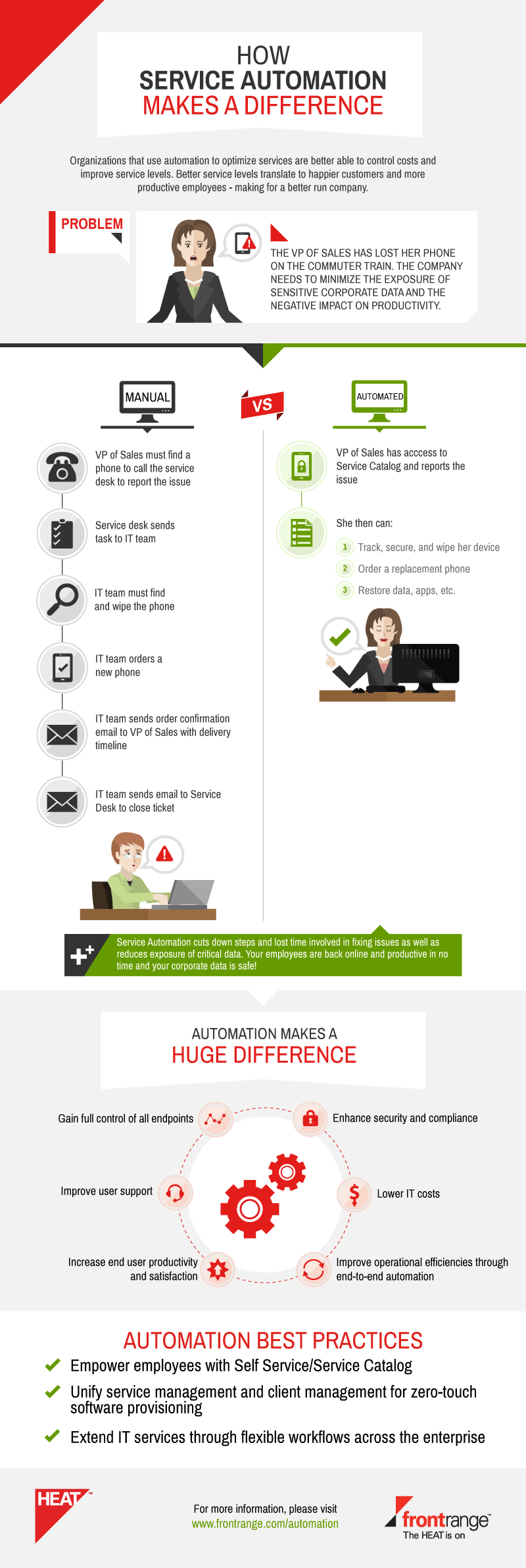In today’s digital age, companies increasingly utilize various external platforms to store and access corporate data. In fact, according to Forbes magazine more than half of all companies in the United States now use some form of Cloud Computing to conduct daily operations. Executives communicate via email on smartphones, employees access corporate systems on laptops from various locations, and documents are reviewed from home with provisioned tablets. Any one of these devices could contain sensitive company data that would result in a valuable loss of time and money should information be compromised. It’s therefore imperative that today’s company—large or small—take appropriate measures to secure and retrieve corporate data across provisioned devices. But how can companies best protect such widescreen read data? The answer now lies with service automation.
Service automation relies on the deployment of a series of automated actions that conduct quick remediation when data loss is reported. Let’s say that a sales executive accidently left her smartphone while in transit to a client’s office for a business meeting. The smartphone contains private company emails, financial information, client records and much more that a company must keep confidential. Without her phone, the executive is confined to conducting work in the office on a personal computer; yet, the nature of her job demands that she work off-site multiple days a week. She’s therefore challenged to mitigate the numerous potential consequences of this situation, and quickly.
With service automation, this executive would be able to immediately report the lost phone to her company’s service catalog, which would then provide her access to locate, secure and even wipe sensitive information from her phone. Right from the service catalog, she can also order a new phone and once the new phone arrives restore all previous data and applications, ensuring an expedient return to business as usual.
Compared to the extended process of a manual response to data loss, which involves reporting the issue to the company service desk, creating a task to be sent to the IT department, completing a manual phone replacement order, and reporting back to the service desk, service automation presents companies with a clear advantage. With service automation, downtime is minimal, other departments remain focused on accomplishing company goals, and corporate data is secured.
About HEATSoftware
 HEAT Software is a leading provider of Hybrid IT Service Management (ITSM & SaaS IT Service Management) and Unified Endpoint Management software solutions for organizations of all sizes. With our suite of HEAT applications, HEAT Software is the only company in the world that provides, from a single platform, Service Management and Unified Endpoint Management software on-premise and in the cloud. HEAT manages millions of service interactions and millions of endpoints every day for thousands of leading organizations across IT, HR, Facilities, Finance, Customer Service, and other enterprise functions. Our customers deliver world-class service while maximizing operational efficiencies with reduced cost and complexity. HEAT Software is headquartered in Milpitas, Calif., and can be found at www.heatsoftware.com.
HEAT Software is a leading provider of Hybrid IT Service Management (ITSM & SaaS IT Service Management) and Unified Endpoint Management software solutions for organizations of all sizes. With our suite of HEAT applications, HEAT Software is the only company in the world that provides, from a single platform, Service Management and Unified Endpoint Management software on-premise and in the cloud. HEAT manages millions of service interactions and millions of endpoints every day for thousands of leading organizations across IT, HR, Facilities, Finance, Customer Service, and other enterprise functions. Our customers deliver world-class service while maximizing operational efficiencies with reduced cost and complexity. HEAT Software is headquartered in Milpitas, Calif., and can be found at www.heatsoftware.com.
The opinions expressed in this post belongs to the individual contributors and do not necessarily reflect the views of Information Security Buzz.




